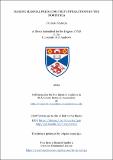Files in this item
Marine mammal predator-prey interactions in the North Sea
Item metadata
| dc.contributor.advisor | Smout, Sophie | |
| dc.contributor.advisor | Hammond, Philip S. | |
| dc.contributor.author | Ransijn, Janneke | |
| dc.coverage.spatial | 233 | en_US |
| dc.date.accessioned | 2023-03-14T13:36:33Z | |
| dc.date.available | 2023-03-14T13:36:33Z | |
| dc.date.issued | 2023-06-14 | |
| dc.identifier.uri | https://hdl.handle.net/10023/27182 | |
| dc.description.abstract | Trophic levels within an ecosystem are linked by the functional response which describes how the consumption rate of a predator varies in relation to prey density. Knowledge of functional responses is key to understanding predator-prey interactions, population dynamics, predation pressure, prey preference, and the ecosystem. This thesis explores multi-species functional responses (MSFR) of key marine mammal predators in the North Sea, and the prey energy available to them. Spatiotemporal variation in prey energy available to harbour porpoises (Phocoena phocoena) was modelled, using species distribution models, and showed that large amounts of energy were available both within and outside the Southern North Sea (SAC). Sandeels are energy-rich, their patchy restricted distribution drove the observed patterns of the spatiotemporal distribution of all porpoise prey energy. The MSFR of three predator species (harbour porpoise, grey (Halichoerus grypus) and harbour seal (Phoca vitulina)) were modelled using Bayesian methodology. Fitted responses indicated that all predators exhibit a type III functional response, and that sandeels are important and more strongly preferred by grey seals and harbour porpoise compared to harbour seals. They may be preferred as they are probably easy to catch due to their immobility and predictable occurrence, as inferred from their restricted modelled distribution. Harbour seals have more diverse diets than grey seals and seem to show a more sigmoidal response which may indicate a greater tendency to switch between prey types. Of the predators, harbour porpoise had the highest consumption estimates, mainly due to the larger number of animals in the area. Generally, marine mammal consumption was low compared to fisheries landings (≤ 20%). Overall, this thesis shows the benefit of MSFR modelling to improve ecological understanding of important marine predators and the results allow future integration of the MSFRs into ecosystem models to explore the consequences of predation on various fish stocks. | en_US |
| dc.language.iso | en | en_US |
| dc.relation | Ransijn, J., Hammond, P., Leopold, M., Sveegaard, S., & Smout, S. (2021). Integrating disparate datasets to model the functional response of a marine predator: a case study of harbour porpoises in the southern North Sea. Ecology and Evolution, 11(23), 17458-17470. https://doi.org/10.1002/ece3.8380 | |
| dc.relation.uri | https://doi.org/10.1002/ece3.8380 | |
| dc.rights | Creative Commons Attribution-NonCommercial-NoDerivatives 4.0 International | * |
| dc.rights.uri | http://creativecommons.org/licenses/by-nc-nd/4.0/ | * |
| dc.subject | Marine mammal | en_US |
| dc.subject | Predator-prey interactions | en_US |
| dc.subject | Multi-species functional response | en_US |
| dc.subject | Sandeel | en_US |
| dc.subject | Harbour porpoise | en_US |
| dc.subject | Harbour seal | en_US |
| dc.subject | Grey seal | en_US |
| dc.subject | North Sea | en_US |
| dc.subject | Prey switching | en_US |
| dc.subject | Distribution | en_US |
| dc.subject.lcc | QL758.R2 | |
| dc.subject.lcsh | Predation (Biology) | en |
| dc.subject.lcsh | Marine mammals--North Sea | en |
| dc.title | Marine mammal predator-prey interactions in the North Sea | en_US |
| dc.type | Thesis | en_US |
| dc.contributor.sponsor | University of St Andrews. School of Biology | en_US |
| dc.contributor.sponsor | Spragge Conservation Scholarship | en_US |
| dc.type.qualificationlevel | Doctoral | en_US |
| dc.type.qualificationname | PhD Doctor of Philosophy | en_US |
| dc.publisher.institution | The University of St Andrews | en_US |
| dc.publisher.department | Sea Mammal Research Unit (SMRU), Scottish Oceans Institute (SOI) | en_US |
| dc.identifier.doi | https://doi.org/10.17630/sta/346 |
The following licence files are associated with this item:
This item appears in the following Collection(s)
Except where otherwise noted within the work, this item's licence for re-use is described as Creative Commons Attribution-NonCommercial-NoDerivatives 4.0 International
Items in the St Andrews Research Repository are protected by copyright, with all rights reserved, unless otherwise indicated.


